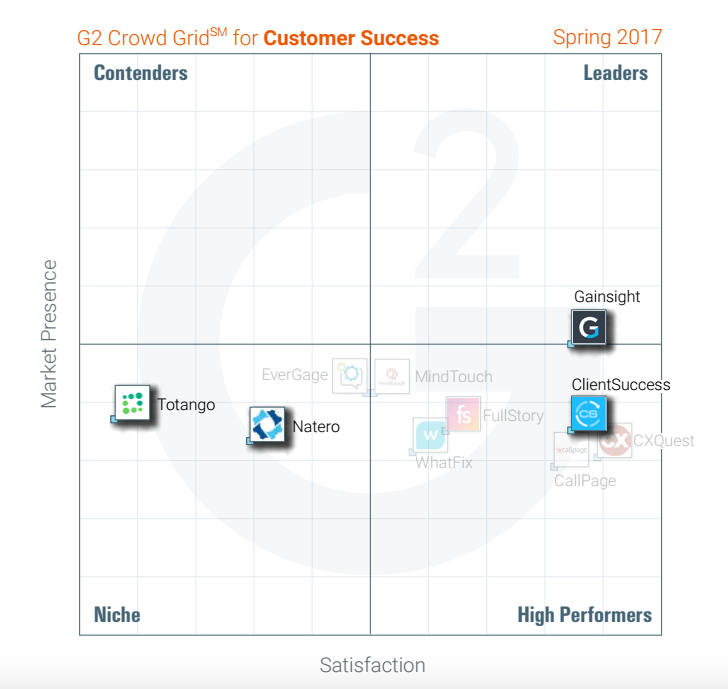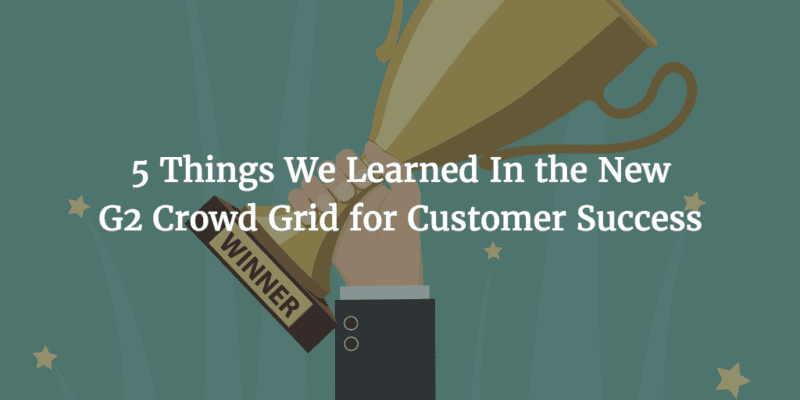What’s the best Customer Success software?
Obviously that’s an impossible question to answer. What’s the best software for you might be more appropriate. Every platform has strengths, weakness, and gaps—the trick is finding out which one meets your unique needs. At Gainsight, we’re really proud of our offering, but we understand it’s not for every company. We think our tool is great, but it can’t possibly be the best, right?
At least that’s what I thought before I read the latest G2 Crowd Grid for Customer Success. While “the best” might be somewhat subjective, it can also be measured objectively, in aggregate. After all, in the world of subscription software, “the best” has two criteria: How many people use the platform? And how successful are they?
G2 Crowd is a trusted review site for business technology, and it’s uniquely positioned to collect, aggregate, and analyze the data points necessary to answer those two questions. It’s a critical stage in the procurement process of many thousands of software buyers around the world. The latest Grid Report for Customer Success was just released, and it ranked the top 10 Customer Success solutions on two axes: Market Presence and Customer Satisfaction. In other words, how many people use the platform and how successful they are.

This is what it looks like, and this is what we learned:
Gainsight is The Leader in Customer Success software
The first thing you’ll notice in the image above (and when you look closer at the complete report) is that there’s only one logo in the top right quadrant. The Grid is divided into four broad categories across the two axes: Niche, Contenders, High Performers, and Leaders. The Leaders category is for solutions that break the threshold in both Market Presence and Satisfaction. Gainsight is the only company that does.
You probably also noticed that several companies are grayed out—though G2 Crowd’s categorization methodology included software like EverGage and MindTouch, they aren’t really Customer Success solutions. MindTouch is a self-service platform for support documentation, for example, and EverGage is a personalization tool in the CX space. In other words, we don’t really compete with any of the grayed out companies for deals.
But even with their logos colored in, Gainsight is still the clear leader, and it’s not even close.
There is significant separation between Gainsight and the competition on both axes
Gainsight’s Satisfaction score is based on 118 G2 Crowd reviews. In context, Totango, Natero, and ClientSuccess combined had less than half that amount. When normalized, Gainsight’s and ClientSuccess’s scores are each 86. Natero’s is 27 and Totango’s is 2. The gap between Gainsight and Natero and Totango is extreme. When you drill down on Net Promoter Score (a component of the Satisfaction rating), Totango’s is just 38. Natero’s is -5. That’s not a typo—it’s negative five.
But on the Market Presence axis, not even ClientSuccess comes close. No one does. The Market Presence score is based on employee count, number of reviews, company age, employee satisfaction, web traffic, and several other factors. Gainsight has more customers, more reviews, more end users, and more employees. Why does this matter? When you trust your customer base to a software solution, you need to know that platform will be there for them in the long term. That means regular updates, consistent support, and the stability to last your company into the future.
Gainsight owns the enterprise space
If this chart was readjusted to include only Customer Success solutions for enterprise-level companies, there would only be one logo on the chart. No other Customer Success platform garnered a review from an enterprise customer.

This accurately reflects our own experience with enterprise-level companies; it’s often a “build-versus-buy” debate between Gainsight and a homegrown solution as opposed to a bake-off between multiple competitors.
It can be complicated to implement Gainsight
When you dive deep into the Grid report (it’s much more than a graph; it’s a 13-page document detailing the methodology and company-by-company results), you’ll notice that the area where Gainsight lags behind the average is mainly due to complicated implementations. Reviewers tend to score Gainsight’s Ease of Use, Admin, and Setup lower than the mean.
Anecdotally, we are well aware of this criticism. Gainsight is powerful, flexible, heavily customizable, and has a lot of features and functionality. It integrates with a wide variety of data sources, and you don’t need clean data to get started. We own this criticism and our engineers are always working to make the tool more intuitive. We also believe that the time and effort are worth it. So do our customers:

—Jamie M. Read More on G2 Crowd

—Steven D. Read More on G2 Crowd

—Nate S. Read More on G2 Crowd
Gainsight can (and will) get better
While this article amounts to a certain level of chest beating, the most valuable thing about the G2 Crowd Grid is that it gives us an objective look at where we can improve. It’s a roadmap pointing out the paths we can take to improve most dramatically. Gainsight is already taking steps to double-down on making our tool easier to setup, admin, and use day-to-day.
In the dynamic, evolving SaaS ecosystem, you get better constantly or you get passed. The G2 Crowd Grid for Customer Success helps us know where we can improve and what the marketplace looks like. One of Gainsight’s Five Values is “Stay Thirsty, My Friends,” and yes, it’s named after the slogan from a beer commercial, but it also perfectly encapsulates our commitment to being ambitious—not in a “crush your enemies” way, but a healthy way. We never want to stop pushing ourselves—and our software—to be better.
I highly encourage you to closely scrutinize the methodology and results. The Grid was developed according to a robust data science algorithm pulling data points from G2 Crowd reviews as well as several other objective sources. Click here to view the entire report in depth.

